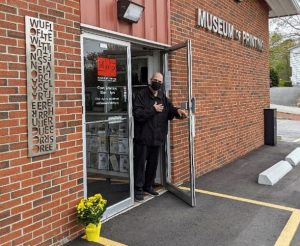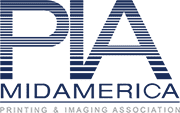Thanks for your contributions to our industry!
Industry pundit Frank Romano turned 80 last year, but he shows no signs of slowing down. He’s just completed his 89th book, which is incredible… that’s more than one book for each year of his life! Many of you know Frank from the weekly videos he does for WhatTheyThink, but his connections to the industry go back much further.
Figure 1: Frank Romano in One of His Many WhatTheyThink Videos
Frank has spent more than 60 years in the printing industry, starting right out of high school at the Mergenthaler Linotype Company in Brooklyn, New York. He founded the publication known as TypeWorld, and has been the editor for many editions of an indispensable industry tool that readers of this blog are certainly familiar with: Pocket Pal: The Handy Book of Graphic Arts Production.
Over the years, Frank has reached thousands of people through his consulting, writing, and speeches. His students will remember his years as a professor at Rochester Institute of Technology (RIT) and California Polytechnic State University (Cal Poly). Frank is the author of many books on topics related to the printing industry, including his trilogy: History of the Linotype Company, History of the Phototypesetting Era, and History of Desktop Publishing.
Frank’s writing is important for us today, but artists, graphic designers, illustrators, typographers, letterpress printers, and historians of the future will be forever grateful for Frank’s work as an author, as well as a guiding light of the Museum of Printing in Haverhill, Massachusetts.
The History of the Ludlow Typograph
Frank’s latest book, The History of the Ludlow Typograph, has just been published. It covers the remarkable tale of a device that is still in use by letterpress printers around the world today. Born at the beginning of the 20th century, the active production lifespan of the Ludlow Typograph lasted just over 80 years, but its impact has continued. In the last decade of the 20th Century as typography evolved from metal to film to digital, many of the fonts in use were based on hot metal libraries. One of the major trendsetters for typographers was the Ludlow Typograph. Frank writes about the people, the company, the machine, and the type library that established typographic tastes. At 535 pages and with over 400 illustrations, this book digs deeper into the history of the Ludlow Typograph than any previous book. For details, see https://museumofprinting.org/news-and-events/.
Figure 2: Frank Romano in Front of a Ludlow Typograph
Machine Writing and Typesetting
One of my favorite Frank Romano books was published in 1986. It’s called Machine Writing and Typesetting: The Story of Sholes and Mergenthaler and the Invention of the Typewriter and the Linotype. Though the title is long, the book itself is short by Frank’s typical standards (only 122 pages) and well worth the time to read. Frank’s astute assessment of the development of the typewriter and Ottmar Mergenthaler’s Linotype takes the reader on a journey through an important era of printing history.
Figure 3: A Younger Frank Romano and His Book, Machine Writing and Typesetting
It should be noted that copies of several of Frank’s books, including Machine Writing and Typesetting, can be found via Oak Knoll Books.
The Museum of Printing in Haverhill, MA
Not one to rest on his laurels, Frank is also President of the Museum of Printing (just off 495 north of Boston at 15 Thornton Avenue in Haverhill, Massachusetts). The museum is dedicated to preserving the rich history of the graphic arts, printing and typesetting technology, and printing craftsmanship. In addition to many special collections and small exhibits, the museum contains hundreds of antique printing, typesetting, and bindery machines, as well as a library of books and printing-related documents. The museum’s Romano Library contains over 6,000 books and thousands of ephemera samples donated by Frank. There is a rare copy of Savage’s 1822 treatise on Decorative Arts and an original Dard Hunter. (William Joseph “Dard” Hunter, 1883-1966, was an authority on printing, paper, and papermaking, especially by hand, using 16th Century tools and techniques.). The Romano library also contains complete sets of the Inland Printer and New England Printer magazines as well as the Penrose Annual and other publications. Most of the collection is housed in custom-made mahogany bookcases. An audiovisual room stores archival slides and electronic media with vintage projectors and converters. The museum also houses the largest collection of material from the Mergenthaler Linotype Company and maintains an archive of material from the phototypesetting and desktop publishing eras.
Figure 4: Frank Romano at the Entrance to the Museum of Printing
The Bottom Line
As you can see, Frank’s contributions to the printing industry are innumerable. Here are some things you can do to benefit from his wisdom:
- Read: Read one of Frank’s books, or take in one of the many books he produced with students in classes at Rochester Institute of Technology (RIT) or California Polytechnic State University (Cal Poly).
- Watch: Watch his weekly videos on WhatTheyThink (you can find recordings of past videos at https://whattheythink.com/articles/author/35/) and check out his videos at the Museum of Printing YouTube page.
- Visit: Visit the Museum of Printing in person at 15 Thornton Avenue in Haverhill, Massachusetts or check out its website at https://museumofprinting.org/. If you are so inclined, consider becoming a member and supporting the work of the museum!
- Follow: Follow the Museum of Printing on social media on Facebook (The-Museum-of-Printing), Instagram (museumofprinting), and Twitter (@MOPrinting).
Source: Jim Hamilton, Consultant Emeritus at Keypoint Intelligence
Author bio: Jim Hamilton of Green Harbor Publications is an industry analyst, market researcher, writer, and public speaker. For many years, he was Group Director in charge of Keypoint Intelligence’s Production Digital Printing & Publishing consulting services. He has a BA in German from Amherst College and a Master’s in Printing Technology from the Rochester Institute of Technology. Full disclosure: Jim is Vice President of the Museum of Printing as well as a Frank Romano groupie!
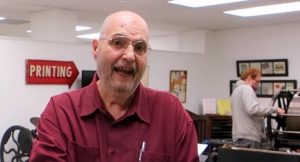
Figure 1 Frank Romano in One of His Many WhatTheyThink Videos
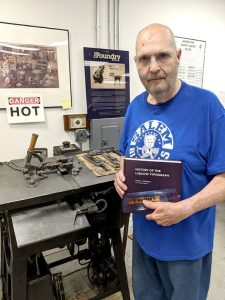
Figure 2 Frank Romano in Front of a Ludlow Typograph
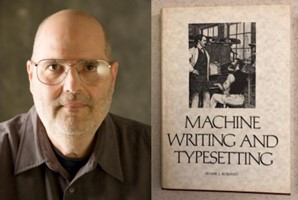
Figure 3 A Younger Frank Romano and His Book, Machine Writing and Typesetting
